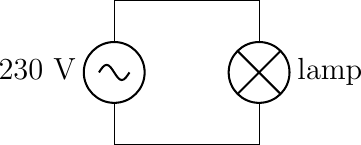5.2.5. Highway to Hell¶
Thusfar we implicitly assumed that the voltage and hence the current is constant in time. But that is often not the case, think of an electric 230 Volt outlet. The voltage is alternating between -325 and +325 volt in a sinusoidal manner. This is called alternating current (AC) in contrast to constant current of direct current (DC).
Consider the sketched circuit (don’t do this at home as the currents can kill you):

Fig. 5.10 Lamp connected to an AC outlet
The voltage \(u\) now is time dependent:
the frequency in Europe is 50 Hz and its amplitude is 325 V. The amplitude of the sine wave is 325 V and not 230 as you might have thought. The number 230 is the amplitude of a dc source with the same power (see a forthcoming section on power).
A negative voltage is what you would get if you would connect a battery in the opposite manner. The (constant) current would then flow in the opposite direction. Mathematically this is modelled with the minus sign.
Ohm’s law still applies in case of alternating currents:
where we assume that the resistance is constant, but now the voltage and current are time dependent. We follow the convention here to write lower case letters for time varying signals.
Obviously alternating currents and voltages is what we are interested in in a course on signal processing. Let \(u_{\text{in}}(t)\) be the input to some electronic circuit and let \(u_\text{out}(t)\) be the output voltage then from a signal processing point of view we are interested in the relation between input and output.
But with only resistors there is little fun in analog electronics, we need other electronic components that behave in a frequency dependent manner. In this introduction we will only discuss two of them, the inductor and the capacitor.
Using only resistors, inductors and capacitors (what are called the passive electronic components) we will then look at using these to build analog filters for audio applications.
But first we look at power in the next section.